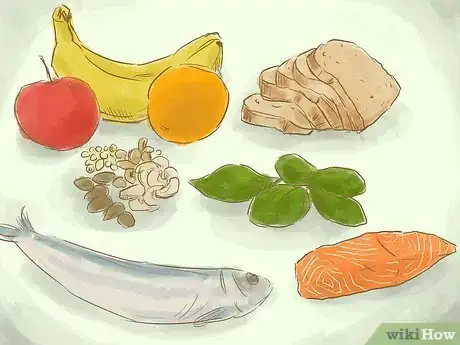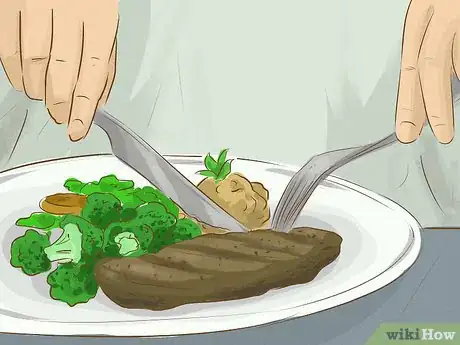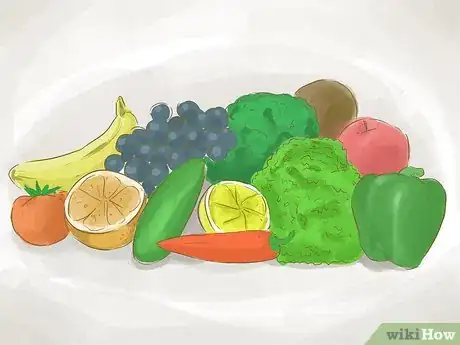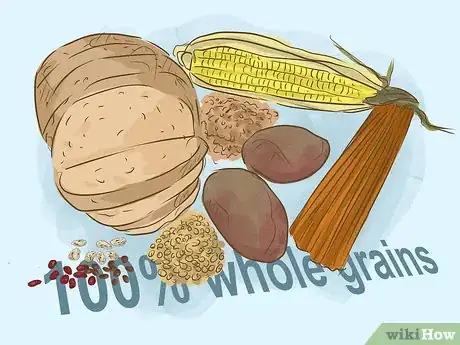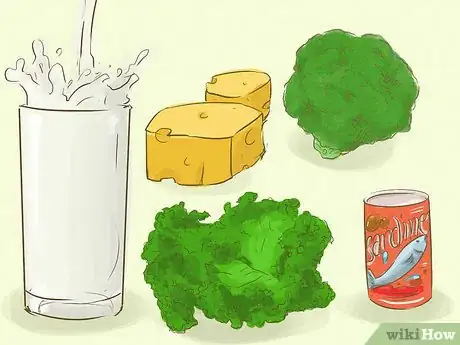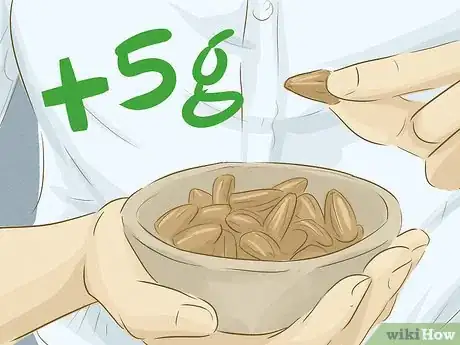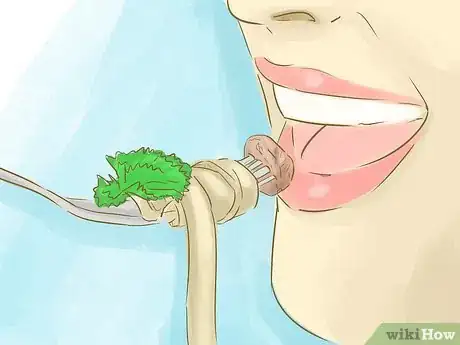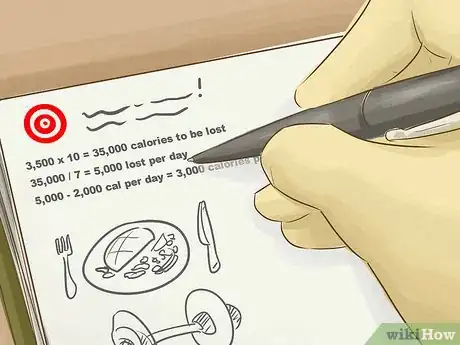This article was co-authored by Lyssandra Guerra. Lyssandra Guerra is a Certified Nutrition & Wellness Consultant and the Founder of Native Palms Nutrition based in Oakland, California. She has over five years of nutrition coaching experience and specializes in providing support to overcome digestive issues, food sensitivities, sugar cravings, and other related dilemmas. She received her holistic nutrition certification from the Bauman College: Holistic Nutrition and Culinary Arts in 2014.
There are 18 references cited in this article, which can be found at the bottom of the page.
This article has been viewed 15,558 times.
Quasi vegetarians are people who think of themselves as vegetarians, but will occasionally eat meat, fish, seafood, or poultry. Quasi-vegetarians may practice this type of diet for health or ethical reasons.[1] You can become a quasi vegetarian by considering your decision, making sensible food choices, and creating meal plans to guide you through each week.
Steps
Living a Quasi Vegetarian Lifestyle
-
1Figure out why you want to be quasi vegetarian. Many people try out vegetarian diets and give it up quickly after starting. Understanding the reason(s) why you want to be a quasi vegetarian can help you make wiser food choices for your health and stick to this type of diet. You may be considering a quasi vegetarian diet for the following reasons:[2]
- Health: A plant-based diet has many health benefits, so you might consider limiting your meat intake to promote better health or target specific health concerns
- Religious convictions: Many religions including Hinduism, Buddhism, and Jainism have long traditions of eating no meat or certain kinds of meat in reverence for animals or as a means of non-violence.
- Animal welfare concerns: Animals are often raised and slaughtered in inhumane circumstances; if you are concerned about the welfare of animals, you may consider being a vegetarian.
- Environmental sustainability: Raising animals for meat can strain environmental resources such as water, air, and land, so you might consider vegetarianism if you are concerned about protecting the environment.
- Household budget: Buying meat can be very expensive, especially if you aim to get organic meat raised and slaughtered in humane ways. You may want to try vegetarianism to reduce your grocery costs.
-
2Decide how often you’ll eat meat. You probably have an idea of how much meat you want to eat each week. Before you start writing your plan, think about how many days to have meat or products with meat such as French onion soup. Consider your reasons for being a quasi vegetarian with the number of days you want to eat meat to figure out your final total.
- Write out factors such as “I want to be healthier and leave as little environmental impact as possible. Having some type of meat two days a week can help me achieve those goals.” You could also decide that you don’t want to cook meat at home and will save it for a treat when you go to a restaurant.
- Follow the Meatless Mondays campaign, an initiative led by Johns Hopkins Bloomberg School of Public Health. Millions of people across the globe participate in Meatless Mondays and it could be a good motivation to stick to your quasi vegetarian diet.[3]
- Try having only one meat-based meal each week. If you wish to have more, consider having fish instead of meat or increase your meat-based meals to two per week.
Advertisement -
3Consider eating only fish, except for in certain situations. Partial vegetarians are people who avoid meat but may eat fish. These people are called pesco-vegetarians or pescatarians. If you want to avoid meat as much as possible, enjoy fish any time you may want meat. You may want to make exceptions and eat meat in certain situations, such as when someone cooks a meal for you.[4]
- Make sure to get sustainable fish species if you are going to eat it. This can ensure you are getting a quality fish that from a sustainable species. You can find information and announcements on sustainable fish species at http://www.seafoodwatch.org.
-
4Eat meat only outside of your home. Cooking meat can sometimes smell bad and stain pots and pans. It also adds to your grocery bill. If you’re trying to save money and your dishes, consider enjoying meat only when you go out for dinner. This can ensure that you are living a quasi vegetarian lifestyle and even save you money.
- Swap out meat dishes for vegetarian choices if you eat out frequently or are invited to others’ homes often. Think about your goals for being a quasi vegetarian and how many times a week you want to eat meat.
-
5Consider eating meat in special circumstances. In some cases, you may need more protein and nutrients such as iron. This might include menstruating, pregnant or lactating women; people doing endurance training; or people with conditions such as iron disorders.[5]
- Talk to your doctor or other medical health professional about your desire to be a quasi vegetarian. He or she will let you know if this type diet is healthy for you. You may also find out that you can reduce meat intake to a certain number of days per week. Ask any questions you may have.
Preparing to be a Quasi Vegetarian
-
1See your healthcare professional. Before you start a quasi vegetarian diet, it’s important to let your doctor know about your plan. This is especially important if you have special health needs, such as having diabetes. Your doctor can inform you if you are healthy enough to be a quasi vegetarian. He or she can suggest ways to get the right balance of nutrients for your health and wellbeing.[6]
- Have an open discussion with your doctor about your plans to be a quasi vegetarian. Ask any questions you may have about a vegetarian diet and any health issues you need to keep in mind as you choose foods.
-
2Meet with a registered dietician. Becoming a quasi vegetarian means that you will probably make adjustments to your diet. Talking to a registered dietician about your plan can help you make sensible food choices and get all of the necessary nutrients to maintain your health.[7]
- Let the dietician know your wishes and any special health considerations you have. Tell him or her the types of foods you like and what you envision eating. For example, you could say, “I’d like to avoid red meat and limit fish and poultry. I enjoy eggs and dairy products.”
- Find a local registered dietician by asking your primary care physician or by using the Academy of Nutrition and Dietetics: http://www.eatright.org/find-an-expert.
-
3Make your final decision. Once you’ve had a chance to consider your motives and meet with health professionals, you can make an informed final decision. Write the advantages and disadvantages of being a quasi vegetarian on a piece of paper to help you in the process. You can then gradually start changing your diet to a quasi vegetarian.
- Consider letting your friends and family know about your decision. They may consider your lifestyle when inviting you for meals or suggesting eating at a restaurant.
Choosing Sensible Foods for Your Wellbeing
-
1Read product labels for hidden meat. If you purchase prepared or processed foods, check the products labels. You may find that some foods contain hidden meat or animal byproducts, including so-called vegetarian or vegan selections. This can keep you from deviating from your quasi vegetarian diet.[8]
- Remember that many foods, such as soups, have meat-broth bases. Sauces such as Worcestershire may have anchovies or other animal products.
- Watch out for gelatin, which is made from boiling the hooves, skin, and tendons of slaughtered animals. Lard is another product made from animal fat and some restaurants or people may fry food in it.
- Consider avoiding processed or pre-prepared foods in favor or whole unprocessed choices.
-
2Select a variety of fruits and vegetables.[9] Fruits and vegetables are often the foundation of a vegetarian diet. They contain important nutrients that can promote your health and wellbeing and keep you feeling full throughout the day.[10]
- Eat four to five servings of fruit and three to five servings of vegetables every day. Getting a variety of vegetables and fruits can ensure you get plenty of nutrients such as Vitamin C, iron, and calcium. Try broccoli, beets, carrots, squash, oranges, blueberries, and raspberries.
- Be aware that ½ cup of 100% fruit or vegetable juice counts as one daily serving.
-
3Incorporate plenty of whole grains. Food such as bread, pasta, and rice are another great way to follow your quasi vegetarian diet. They can also help you get vital nutrients such as Vitamin B, magnesium, and iron.[11]
- Eat six to eight servings of breads and grains every day. Make sure that at least half of your servings are from whole grains such as brown rice, whole wheat pasta, and quinoa.[12]
- Select grains fortified with iron, Vitamin B, fiber and protein for an added boost of nutrients.
-
4Enjoy different kinds of dairy. Vegetarians, unlike vegans, consume dairy products that come from animals including cows, sheep, and goats. Dairy products are an excellent source of protein, calcium and Vitamin D. They can also substitute for nutrients found in meat.[13] Aim for two to three low-fat servings of dairy per day from foods such as:[14]
- Cheese
- Milk
- Yogurt
- Ice cream
- Sour cream
- Cottage cheese
- Butter[15]
-
5Calculate your protein needs. Everyone needs protein to stay healthy.[16] Protein is one of the primary building blocks of muscle hair, blood, and connective tissue. You should try and get the Recommended Daily Allowance (RDA) of protein for, which is 0.8g per kilogram of weight, each day.[17]
- Figure out your personal RDA of protein with an online protein calculator. You can find them at sites such https://www.nal.usda.gov/fnic/dri-calculator/.
- Be aware that the RDA is for a person who gets little to no activity. If you are active, double your calculated your RDA.[18]
-
6Get protein from animal and plant sources. Meat is one of the best sources of protein and nutrients including Omega-3 fatty acids. But as a quasi vegetarian, you are decreasing or avoiding certain types of meat. You can choose when you want to have some meat and get your protein from other animal and plant sources. Some sources of protein for quasi vegetarians that are not meat or fish are:[19]
Planning for a Practical Quasi Vegetarian Diet
-
1Vary your diet. Each food you choose contains different nutrients. Eating a wide array of foods can provide you vital nutrients to stay healthy.[22] As a quasi vegetarian, this is important because there are foods you can’t eat. Make sure to eat as many different kinds of food as you can every day.
-
2Write a meal plan for each week. Meal plans are a great way to track what you’re eating and may streamline your food shopping.[23] Writing a plan at the start of each week can ensure you’re getting enough nutrients and aren’t inadvertently eating more meat than you want. Consider keeping on a large erasable board in your kitchen so that you can see the plan for each day.[24] Your weekly plan might look like:
- Monday: smoothie with avocado and whole wheat toast with almond butter for breakfast; mixed green salad and spinach tortellini with parmesan cheese for lunch; vegetable omelet with salsa and sour cream for dinner.
- Tuesday: for breakfast, you could have steel cut oatmeal topped with fresh pineapple, raspberries, mango, and blueberries; for lunch, a cup of vegetable soup with a grilled cheese sandwich; a piece of salmon, steamed vegetables, and a cup of Greek yogurt with fresh fruit for dinner.
- Wednesday: for breakfast, a bagel with cream cheese and bell peppers; a large salad with vegetables including kale, carrots, tomatoes, asparagus, beets, some low-fat cheese and two hard-boiled eggs for lunch; for dinner you might have chili with kidney and black beans and tofu and two corn tortillas.
- Thursday: whole grain cereal with milk and fruit for breakfast; pasta with steamed vegetables and tomato sauce for lunch; a mixed salad with nuts and cheese, falafel, and hummus for dinner.
- Friday: have a whole grain blueberry waffle with syrup and fresh fruit for breakfast; rice noodles with vegetables, egg and curry sauce for lunch; and for dinner have vegetable pizza.
- Saturday: let yourself splurge on a cinnamon roll for breakfast; a mixed salad and tomato soup for lunch; make a steak or chicken with grilled vegetables for dinner or enjoy a meal at your favorite restaurant.
- Sunday: give yourself a free day to eat whatever you like.
-
3Be a gracious guest. Chances are that you will get invited for meals at other homes or in restaurants. If your hosts ask you if you have dietary restrictions, let them know you are a quasi vegetarian. They may accommodate you, but you should never expect or demand that others prepare or buy different food just for you. Instead, remember that you are a quasi vegetarian and do eat meat and fish at times. This can help you be a gracious guest who doesn’t offend or upset another person.
- Try a bite of each dish if you are at someone else’s home for dinner. This will shows a good faith effort on your part and may prevent uncomfortable situations. Keep in mind that you don’t have to like something, but that you should try everything.[25]
- Make appropriate selections or substitutions when you go to restaurants. Many places are willing to accommodate guests. Most buffets offer a variety of meat and meatless foods.
Expert Q&A
Did you know you can get expert answers for this article?
Unlock expert answers by supporting wikiHow
-
QuestionWhat should I keep in mind when changing to a new diet?
 Lyssandra GuerraLyssandra Guerra is a Certified Nutrition & Wellness Consultant and the Founder of Native Palms Nutrition based in Oakland, California. She has over five years of nutrition coaching experience and specializes in providing support to overcome digestive issues, food sensitivities, sugar cravings, and other related dilemmas. She received her holistic nutrition certification from the Bauman College: Holistic Nutrition and Culinary Arts in 2014.
Lyssandra GuerraLyssandra Guerra is a Certified Nutrition & Wellness Consultant and the Founder of Native Palms Nutrition based in Oakland, California. She has over five years of nutrition coaching experience and specializes in providing support to overcome digestive issues, food sensitivities, sugar cravings, and other related dilemmas. She received her holistic nutrition certification from the Bauman College: Holistic Nutrition and Culinary Arts in 2014.
Certified Nutrition & Wellness Consultant
References
- ↑ https://experiencelife.com/article/the-new-veganism/
- ↑ http://www.health.harvard.edu/staying-healthy/becoming-a-vegetarian
- ↑ http://www.meatlessmonday.com/the-global-movement/
- ↑ http://www.health.harvard.edu/staying-healthy/becoming-a-vegetarian
- ↑ http://www.ncbi.nlm.nih.gov/pmc/articles/PMC3999603/
- ↑ http://familydoctor.org/familydoctor/en/prevention-wellness/food-nutrition/weight-loss/vegetarian-diet-how-to-get-the-nutrients-you-need.html
- ↑ http://www.eatrightpro.org/resource/practice/position-and-practice-papers/position-papers/vegetarian-diets
- ↑ http://eatdrinkbetter.com/2012/01/20/food-labels-for-ecovores-avoiding-hidden-animal-ingredients/
- ↑ Lyssandra Guerra. Certified Nutrition & Wellness Consultant. Expert Interview. 25 March 2020.
- ↑ http://www.heart.org/HEARTORG/HealthyLiving/HealthyEating/HealthyDietGoals/Suggested-Servings-from-Each-Food-Group_UCM_318186_Article.jsp#.V4P2lumRjdk
- ↑ http://www.choosemyplate.gov/grains-nutrients-health
- ↑ http://www.heart.org/HEARTORG/HealthyLiving/HealthyEating/HealthyDietGoals/Suggested-Servings-from-Each-Food-Group_UCM_318186_Article.jsp#.V4P2lumRjdk
- ↑ http://www.healthyeating.org/Healthy-Eating/All-Star-Foods/Milk-Dairy.aspx
- ↑ http://www.heart.org/HEARTORG/HealthyLiving/HealthyEating/HealthyDietGoals/Suggested-Servings-from-Each-Food-Group_UCM_318186_Article.jsp#.V4P2lumRjdk
- ↑ http://www.dairyfoods.com/topics/2623-dairy-foods-beverages
- ↑ Lyssandra Guerra. Certified Nutrition & Wellness Consultant. Expert Interview. 25 March 2020.
- ↑ http://www.health.harvard.edu/blog/how-much-protein-do-you-need-every-day-201506188096
- ↑ http://www.health.harvard.edu/blog/how-much-protein-do-you-need-every-day-201506188096
- ↑ http://kidshealth.org/en/kids/vegetarian.html
- ↑ http://www.health.com/health/gallery/0,,20718479,00.html
- ↑ http://www.askdrsears.com/topics/feeding-eating/family-nutrition/vegetarian-diets/12-frequently-asked-questions-about-vegetarian-diet
- ↑ Lyssandra Guerra. Certified Nutrition & Wellness Consultant. Expert Interview. 25 March 2020.
- ↑ Lyssandra Guerra. Certified Nutrition & Wellness Consultant. Expert Interview. 25 March 2020.
- ↑ http://www.discovergoodnutrition.com/2013/10/sample-diet-plan/
- ↑ http://www.epicurious.com/archive/blogs/editor/2007/07/confession-of-a.html


